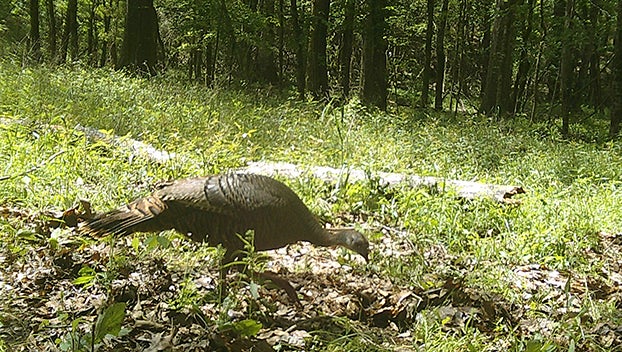Look to turkeys to beat the heat
Published 10:00 am Thursday, August 1, 2024

- A hen scratches for food in a food plot in Lincoln County. (Hunter Cloud's Trail Camera | The Daily Leader)
BROOKHAVEN — Forecasts are not favorable for anyone who needs to cut grass, manage habitat or simply enjoy the outdoors. Temperatures are expected to reach the upper 90s with heat indices between 111 to 115 degrees Thursday and Friday.
Unlike humans, turkeys have no real escape from the day to day conditions and weather. They have no air-conditioned homes or a way to take a quick chill in a beer cave at your favorite gas station.
Find cool shade
Turkeys also have a coat of feathers which serves to keep them warm in the winter months. It is only logical to look at how they beat the heat to apply to any active management practices.
One way turkeys beat the heat is by finding thermal cover in the summer which provides cooling shade. See for yourself the difference between a field and the shade of a thicket of young trees or a mature hardwood stand.
You may notice these hardwood stands happen to be in streamside management zones. In our neck of the woods, streams can be found in well shaded hollers where a cooling breeze makes a huge difference.
August is a great time of year to assess if your property has adequate thermal cover for turkeys. For one, you can feel the difference in temperature between different cover types. Walk your property to get a good understanding of how diverse different cover types are and look at how close they are to water. Thermal cover is not only helpful to turkeys but it can be useful to deer.
Water is needed
The National Weather Service advises people to drink plenty of water and stay hydrated during heat waves and advisories. Turkeys need water, especially clean drinking water.
According to the National Wild Turkey Federation, adult wild turkeys need a quart of water per day. Water can be obtained by drinking water from streams, small puddles in old tree stumps or rocks, insects and plants consumed by the bird.
Water is also needed by turkey poults, baby turkeys, which should be hatched and growing right now. Poults get water from their egg’s yolk sack for the first few days of life and once it is used up, poults obtain water from dew and insects they eat.
A good management assessment right now is to walk your poult rearing habitat and habitat in general to see if there is an abundance of insects on the landscape.
Turkeys need water daily just like humans do. According to The National Wild Turkey Federation, hens rarely nest more than a quarter of a mile away from a water source. Land managers may want to assess the proximity of their nesting cover to water sources.
In the event of droughts, berries and other soft mast struggle to produce. For example, muscadines and beautyberries died before they could mature last year following the drought in Lincoln County. The subsequent consequences could negatively impact turkeys in the winter.
Flooding can have a negative impact on hen nest survival but it can be a good natural disturbance. Riparian plants are often regenerated by floods which benefit turkeys.
The National Wild Turkey Federation stated that turkeys can drink out of ditches and mud puddles as long as the water sources do not contain pesticide, oil, road salt or fertilizer chemicals.





